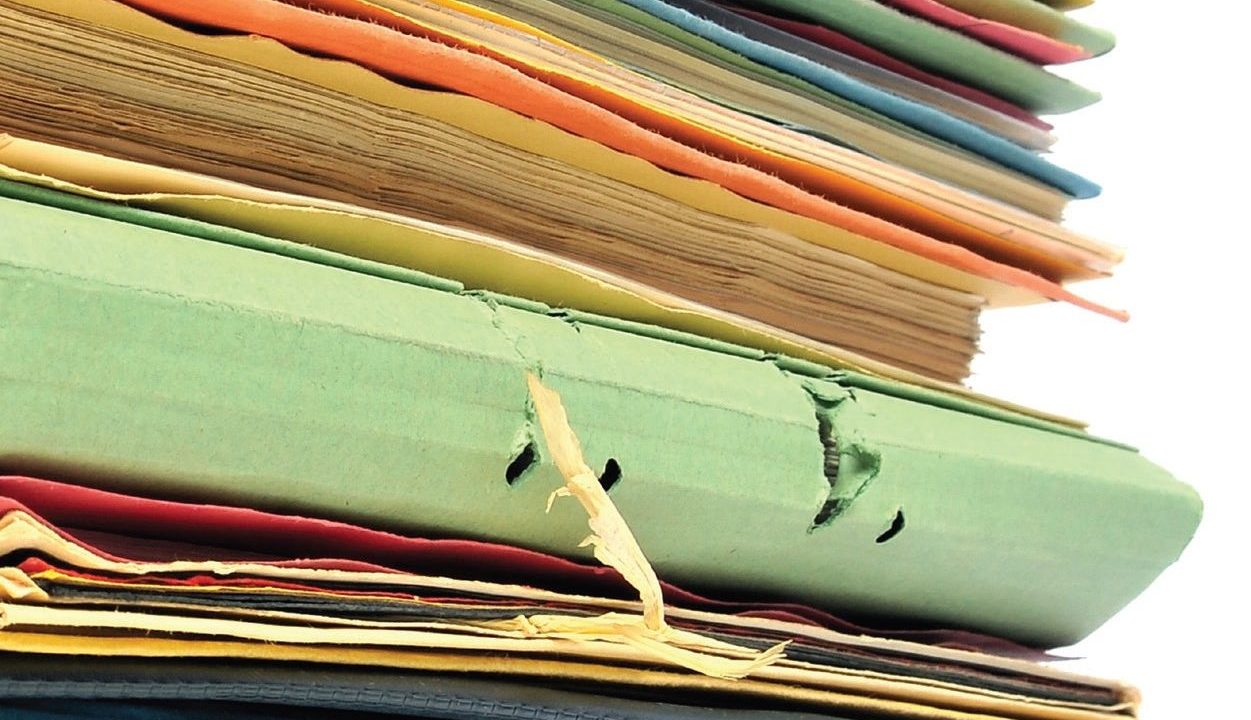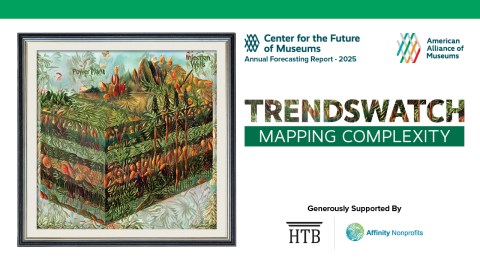
The American Alliance of Museums Core Documents Verification is a review and recognition program that focuses on the five core indicators of a strong and healthy organization:
- Mission Statement
- Institutional Code of Ethics
- Strategic Institutional Plan
- Disaster Preparedness/Emergency Response Plan
- Collections Management Policy
These documents contain essential information and reflect the best practices and standards of professional museums. But for many people working in and with small museums, assembling this list can be daunting. In an institution where everyone is wearing multiple hats and it seems as if there are never enough bodies or time to get everything done, writing and revising document after document can seem impossible. The prospect of submitting the documents for review raises the stress level even more.
Thinking of the five core documents as a monolithic block can be overwhelming. But if you work with just one document at a time, the task is manageable. AAM will accept the submission of individual documents. Remember that you don’t have to start with a blank slate. There are many excellent resources and examples that can help you develop your core documents. As you begin to review or create each document, you’ll realize that they build on each other. The workload will decrease as you continue.
Developing good documents is time-consuming Doing the work ahead of time is more efficient than spur-of-the-moment tactics. The process of developing the documents can also be an eye-opening experience for the institution. It gets everyone thinking seriously about the purpose of the organization as well as professional standards. Many institutions become much stronger after working through their core documents and submitting them for verification.
Following are guidelines and tips for developing each of the five core documents.
Mission Statement
Begin with the mission statement. It’s the foundation for everything else, explaining the purpose of the organization, outlining its path, and acting as a guide for operations and decision making. The mission statement should be visible to everyone in the institution and be included in each policy.
Most institutions already have a mission statement, even if it’s just the purpose statement from the bylaws. Take a look at it. What does it say? Is it easy to understand? Does it describe what the institution does? How can you revise it to reflect your institution? Could you distill it to one or two sentences that really tell people what you do?
Good questions to ask before developing a new policy, creating a new program or planning a new exhibit are “Does this further our mission?” and “How does it fit our mission statement?” If the project furthers the mission and the “fit” can be clearly articulated, then the project is probably appropriate for your institution.
As an institution changes, the mission statement should be reviewed. Changes to the institution can be anticipated and could indicate that the mission statement should change. An organization may grow beyond the current mission statement. The community it serves may change significantly. Economic and demographic pressures may trigger changes in plans and projects.
Reviewing and revising the mission statement in a thoughtful way can re-energize an institution. Often when the board, staff, and volunteers discuss the mission statement, they discover surprising things and open new doors. Overhauling the mission statement, however, should never be undertaken lightly. Any revisions should be carefully considered and discussed by the board, paid and unpaid staff, and community stakeholders. Because the mission statement is the basis for all institutional decision making, changing it should be a thoughtful and thorough process.
Institutional Code of Ethics
A code of ethics ensures that everyone understands the legal and ethical responsibilities of individuals who work in and govern institutions. Because nonprofits serve in the public trust and not for their own benefit, everyone must be familiar with local, state and federal laws, as well as best practices for museums and nonprofits. Board, staff, and volunteers have a duty to be aware of the legal responsibilities and ensure that the organization upholds them.
In addition to legal considerations, each organization has ethical responsibilities to uphold. Any resources held by the organization must be used wisely and prudently in accordance with its principles. A code of ethics should address the duties and responsibilities of the organization’s governing authority, including adherence to best practices; ethical and efficient use of resources; and the disclosure of any conflicts of interest held by board members, staff or volunteers. It should address the appropriate care and use of museum collections, as well as inclusion and diversity in all institutional matters.
The code of ethics gets everyone on the same page and addresses the full disclosure of any conflicts of interest. It establishes the principles that will inform the strategic plan, shape the collections management policy and guide financial decisions.
Strategic Institutional Plan
The strategic institutional plan is your roadmap and the most necessary document. It can be one of the most difficult to create, and the process should not be rushed. It is a long-range, comprehensive guide for the institution, requiring a lot of discussion, thought, and negotiation. A good plan gets everybody going in the same direction for the good of the institution. It tells everyone how you’re going to fulfill your mission. The plan holds everyone accountable for accomplishing the goals and objectives that will move the institution forward. It assures that you will use organizational resources in the best and most efficient ways possible, and forms the basis for the other core documents.
Without a strategic plan, an institution runs the risk of always reacting to changes in its situation. Instead of working through change and handling tough situations in positive ways, an institution with no plan may develop the habit of continuously operating in crisis mode. Going from crisis to crisis is stressful for everyone involved and isn’t a sustainable mode of operation. An institution without a strategic plan is facing a slow disaster.
A good plan addresses the institutional path for three to five years in the future. Each element should reflect the mission statement and should be developed with input from the board and paid and unpaid staff. Community stakeholder input can help determine how the community views the institution, indicate whether the institution is meeting the needs of the community and give individuals inside the organization a broader, external viewpoint.
Going from crisis to crisis is stressful for everyone involved and isn’t a sustainable mode of operation. An institution without a strategic plan is facing a slow disaster.
Strategic plans should address:
- institutional goals and objectives
- tasks necessary to reach goals
- resources needed, including people, time and funds
- groups or individuals responsible for implementing the elements of the plan
- methods for determining the completion of the tasks and evaluating the outcomes
Small museums are nimble and often very good at adapting on a moment’s notice. Having a well-developed strategic plan makes this much easier. If the strategic plan addresses bigger issues, small problems can be handled with less disruption.
Disaster Preparedness/Emergency Response Plan
Emergencies happen at museums every day. An emergency is an unanticipated event that requires immediate action. A disaster is an emergency that has gotten out of control and may cause significant damage. A plan is key to minimizing the damage caused by either an emergency or a disaster. It addresses professional standards as well as institution-specific risks and hazards. It provides instructions for the appropriate actions to take before, during and after the event to protect people and objects from risk and guidelines for salvage and recovery to minimize the effects of a disaster. Steps to take before an emergency include prevention, mitigation, and preparation for the emergency.
It is important to assign tasks and responsibilities and train everyone involved with the institution to implement the plan. Working with local first responders is essential to creating a comprehensive plan. They can explain the Incident Command System and give advice about handling people, who are often the most random element involved in an emergency or a disaster.
In response to growing awareness about the need for comprehensive disaster preparedness/emergency response plans, more and more resources have become available. Online resources include dPlan™ (an online disaster planning tool for cultural and civic institutions), recorded webinars on the Connecting to Collections Online Community, and the Emergency Response and Salvage Wheel mobile app. PReP™ (Pocket Response Plan) is a concise document for recording essential information for anyone at the institution in the event of a disaster. The template is available online, and the plan can be customized for your institution.
Organizations in many states created workshops and training programs as part of the IMLS Connecting to Collections initiative and are happy to share information. Questions to guide your planning, lists of materials for disaster preparedness kits, fill-in-the-blank forms and information about the Incident Command System are provided with most of these resources. Reviewing them, using the provided templates and answering the questions can help identify your institution’s needs and resources. All of them are designed to make disaster preparedness and emergency response planning as uncomplicated as possible.
Collections Management Policy
Both the mission statement and the strategic plan should inform your collections management policy. Everything you collect should support your mission and be a part of the strategic plan. Many institutions can explain their collections policies and procedures but have not taken the final step of writing the information down.
Meeting with the individuals who have been most involved in the collections work and asking them to outline their processes will give you a place to start. Often you just need to write the information down and expand on it. Putting the collections management procedures in writing will codify the information and identify gaps and inconsistencies to be corrected. As with all policies, you should include provisions for regular review and revision.
A good collections management policy is important for any collecting institution. It provides guidelines for why, how and what the institution collects, and how collections are processed and handled. The policy should also identify who is empowered to make decisions about acquiring and deaccessioning objects, and how those decisions are made. A strong collections management policy is the basis for good collections stewardship.
Important elements of the collections management policy include:
Scope of collections: This statement sets the boundaries for the collection. It limits the collection and guides decisions about acquisitions and deaccessions.
Types of collections: Collecting institutions can have many types of collections, including but not limited to permanent, education and research. Each type of collection may have different standards of care and ways in which the objects are used. The policy should address these differences.
Means of acquiring, accessioning, deaccessioning and disposing of objects: The policy should provide guidelines for how an institution accepts, processes and removes objects from its collections.
Collections care, preservation, access and use: Institutions are the custodians of the objects in their collections. The policy provides guidance on the physical handling, storage, exhibition and use of collections objects by the institution and by individuals and organizations outside of the institution.
Provision for review and revision: Every policy should include instructions on review and revision. Board members and paid and unpaid staff should review the collections management policy annually. Review is especially important if there has been a change in the institutional mission statement.
Resources
American Alliance of Museums Core Documents Verification
Connecting to Collections Online Community
Heritage Preservation’s Emergency Response and Salvage Wheel
Tamara Hemmerlein is assistant director of local history services, Indiana Historical Society, Indianapolis. As the former Hoosier Heritage Alliance coordinator, she implemented Indiana’s Connecting to Collections project. She serves as chair of AAM’s Small Museum Administrators Committee, and is the Indiana state team leader for the American Association for State and Local History.







